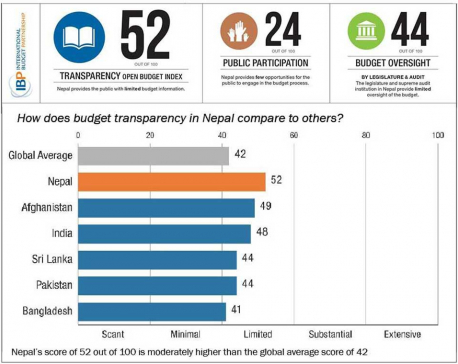
OR
Opinion
Nepal's Next Budget Must Remodel its Conventional Epigraph
Published On: March 16, 2022 07:33 AM NPT By: Hari Prasad Shrestha

Remittance is the most easy and conventional source to run the economy. However, in the long run, it could be more dangerous and riskier for the economic health of the nation.
Economy in Problem
Whether Nepal’s economy is moving toward the Sri Lankan path, or it's only an exaggeration? Opinions of economists are divided and mixed to this question. Some say it is an exaggeration while many others are of the opinion that the economy is on a critical edge with high risks and its fall could be disastrous and if once crashed, it may take decades to bring it back to earlier stages. However, it is fact-based that major indicators of the economy are below satisfactory level, and the fiscal and monetary instruments seem to be stagnant or demonstrating rearward trends.
The government has also realized the fact that the economy is not in a satisfactory condition and extensive discussions are going on among government authorities and other stakeholders. Recently, Prime Minister Sher Bahadur Deuba interacted with key government officials including the Vice Chairman of the National Planning Commission, Finance Secretary, Governor of Nepal Rastra Bank, Industry and Commerce Secretaries on the current economic situation of the country. Moreover, he also met and discussed with development ministries, private sector representatives, among others, the state of the economy.
According to the statistics published by the central bank of Nepal, for six months of this year, there has been a decline of 5.5% in the flow of remittances, which is a pillar of the Nepali economy. Its contribution to the economy is 28 percent, based on the budgetary allocations.
Moreover, in the same period, imports soared by 51.1 percent to around Rs 1 trillion and the inflation rate reached 5.65 percent. During the period, the government’s current account deficit was 3.54 billion and balance of payment negative by Rs 2.41 billion.
These indicators show the troublesome conditions the economy is in. It can be blamed on COVID-19 to some extent, however, there are also many other factors responsible for it.
Flop policies
We must come out of the hangover of an import- and revenue-based economy, sustained by remittances received from abroad. Remittance is the most easy and conventional source to run the economy. However, in the long run, it could be more dangerous and riskier for the economic health of the nation.
And our policies have been more supportive to trading than to industrial and agriculture sectors, which is causing extreme imbalances in the balance of trade and draining our foreign currency reserves.
It has been proved that Nepal is completely inefficient in timely execution and timely completion of national pride projects. The national pride projects do not include mega and sophisticated projects, which could bring real change in the national economy and development, which are fertilizer plants, oil refinery, mega hydropower, food and textile industries, city transports, waterways, mines explorations, oil and LPG gas storage plants, solid waste management, satellite stations etc.
It would be relevant to note that our cities are not eco-friendly. Vehicular and industrial emissions increasingly have contributed to poisonous air pollution in urban areas. We are highly dependent on fossil fuels for transportation, cooking and other purposes. We have failed to decrease the consumption of fossil fuels and replace them with renewable energies.
Another sign of our flop economy is that there are hundreds of programs linked to poverty reduction in Nepal and the three tiers of government spend billions of rupees on these programs. And our entire policies seem to be ineffective, especially to the persons with disabilities, Dalit communities, abandoned children and displaced persons, landless persons, or those with very few assets, bonded laborers, illiterate and unemployed populations, among others.
Due to unfavorable investment climates, multinational companies (MNCs) are not interested in investing here. The Nepal-India Trade Treaty 1996 crafted some favorable business environment for the Indian multinational companies to enter Nepal, thereafter, very few MNCs entered the country, and some major companies returned and refused to invest here. Reliance cement of India, Dangote of Nigeria left the country due to administrative hassles and difficulties and some other investors are finding difficulties in transferring their dividends.
A large amount of our budget is being spent on unnecessary and unproductive plans and programs and if we fail to stop these expenses, we are going to face more new problems in the economy. At the same time, Nepal must be very careful taking an excessive burden of social security allowances as it is already spending the highest percentage in social security support compared to other countries in South Asia.
Corrective measures
Some of the major imported goods of Nepal such as petroleum products, gold, foods, vehicles, vegetables and garments have strong pressure on its foreign currency reserve. It is possible to decrease the import of many of these items, such as, by substituting petroleum with electricity and by facilitating the import of at least a kilo of gold by Nepalis living abroad for more than a year.
For export trade and import substitution, we must revitalize our dead garment, and carpet manufacturing sectors, by inviting domestic, non-resident Nepalis and international partners to invest in medium- and large-scale industries for export. Moreover, in a similar way, investments are also needed in processing of primary products, handicrafts, gold and diamond ornament industries through organized companies and export processing zones of Nepal.
Even if there is loss of revenues, special assistance is needed for the development of textile and food industries which are high necessity items. The provision of anti-dumping duty and countervailing duty to protect domestic industries should be strictly implemented.
Now it has become urgent to encourage the private sector in petroleum import and transmission lines to check government monopolies and the government must build and operate city transport networks, railways and establish large public construction companies to check and balance the private monopolies.
We should not forget that agriculture is the backbone of the economy, which is in its very primitive stage. Without affecting primary agriculture bases, foreign investment must be allowed in the agriculture sector. The government should have an efficient demand, supply and storage information system of necessary food crops. Some economists presume that the government should always have control over 25 percent of national food production to stabilize the food market.
Moreover, the government must discourage the provision of duty-free privileges to import goods and services of foreign-funded projects.
One of the most surprising aspects of the commercial banks in Nepal is that they never go into losses and distribute huge bonus amounts. Why are commercial banks always in profit, compared to other sectors of the economy? It should be a subject of investigation and research.
Conclusion
Now, Nepal cannot get an excuse for being least developed only blaming political instability, internal mismanagement, execution incapacity and lack of resources. The bottleneck in the economy lies in the government’s inability to spend the development budget satisfactorily.
Nepal lacks sincerity in following modern economic theories to leap forward to start industrialization by building advanced capital intensive manufacturing industries, by setting up modern financial systems or by erecting modern institutions to support it, to compete with regional and international markets.
For a balanced and efficient transformation of the economy, there needs to be a new political commitment on the part of the political parties at the local, provincial and national levels. As we have adopted a federal structure of governments, the federal government should not be engaged in petty projects and the provincial and local governments must be well-equipped with skilled manpower and resources to handle medium- and small-scale projects and programs at the local level efficiently.
(Shrestha is a former Under-secretary at the Ministry of Finance, Nepal, and an Expert in UNDP Africa)
You May Like This

Budget for next fiscal year to focus on economic revival, growth
KATHMANDU, May 6: The government is preparing the budget for the Fiscal Year 2022/23, focusing on the revival of the... Read More...

Nepal ahead of other South Asian countries in budget transparency list
KATHMANDU, Feb 3: Nepal has ranked at the 43rd position in Open Budget Index 2017, out of 115 countries covered in... Read More...

Budget implementation challenging-UML Leader Nepal
DHADING, June 18: CPN-UML leader Madhav Kumar Nepal has said that the populist budget brought by the incumbent government will... Read More...





Just In
- NRB introduces cautiously flexible measures to address ongoing slowdown in various economic sectors
- Forced Covid-19 cremations: is it too late for redemption?
- NRB to provide collateral-free loans to foreign employment seekers
- NEB to publish Grade 12 results next week
- Body handover begins; Relatives remain dissatisfied with insurance, compensation amount
- NC defers its plan to join Koshi govt
- NRB to review microfinance loan interest rate
- 134 dead in floods and landslides since onset of monsoon this year













Leave A Comment